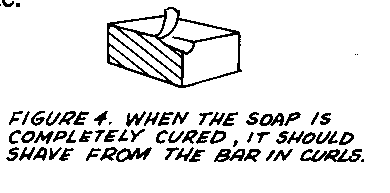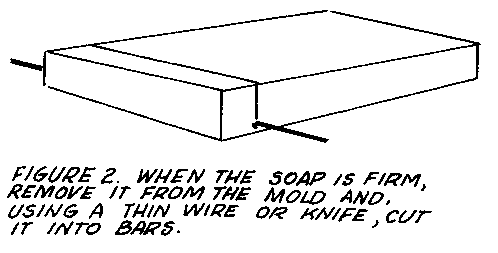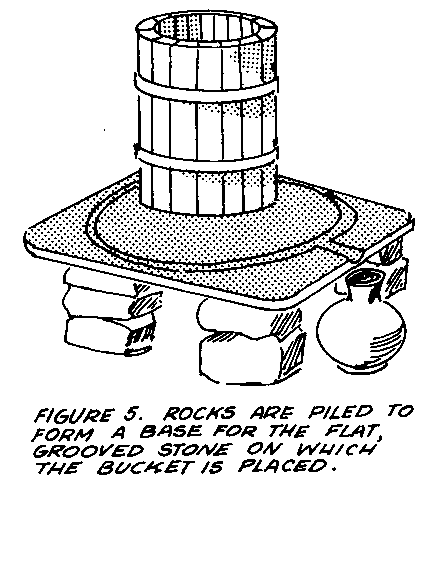Home Soap Making
Soap is an essential cleaning agent, helping people to keep
themselves and their
surroundings clean. When soap is mixed with water, it forms
a lather that washes
out dirt and grease far better than water alone.
Soap can be made on a small scale in the home or village
cheaply and easily. The
main ingredients are fats and lye, both of which can be made
from materials
found throughout the world. Making soap at home is practical
when there is waste
fat or oil and when there is no cheap source of soap.
TWO BASIC METHODS
The two basic methods for small-scale soap making are:
Method 1. With commercial lye: This method is used when
commercially-prepared
lye or
caustic soda (sodium hydroxide crystals) is available.
Method 2. With lye leached from ashes (potash): This method
is patterned after a
process
used by early settlers of North America.
The first method, soap-making with commercial lye, is
recommended because it is
simpler and more reliable.
INGREDIENTS FOR SOAP
Fats and Oils
Soap can be made from either animal fat or vegetable oil.
Mineral oil cannot be
used. Animal fats commonly used are tallow, mutton, and
lard. Vegetable oils used
include coconut, palm nut, maize, olive, cottonseed,
soybean, groundnut, safflower,
and castor. Chicken fat, which is not a hard fat, is
considered an oil. The best
soap is made from a mixture of fat and oil.
o If you want a hard
soap for use in hot water, use only tallow, made from
melting rendered
sheep, cattle, or horse fat.
o If you want a good
laundry soap, use 1 part tallow to 1 part lard or cooking
grease from melted
hog fat, skin, and bones.
o If you want a fine
toilet soap, use 1 part tallow to 1 part vegetable oil.
The best vegetable oils are made from crushing dried coconut
meat, palm nut
kernels, or the outer pulp of the palm nut. The last makes a
harder soap than the
coconut meat or kernels.
Lye
Either commercially-prepared lye, also called caustic soda
or sodium hydroxide
(NaOH) crystals, or lye leached from ashes, called potash,
can be used. Caustic
soda is cheap and is sold in the markets of most countries.
* * * CAUTION * * *
Lye is a corrosive poison. It can cause serious burns. Do
not let the
lye crystals, dust, or solution touch your skin. Wear rubber
gloves and
protective eye wear. If any crystals do touch your skin,
wash with
water and then with a vinegar solution. If any of them are
swallowed,
take as much vinegar, citrus juice, or rhubarb as possible
and call a
doctor.
*
* * KEEP LYE AWAY FROM CHILDREN * * *
Borax
Borax is not necessary for making soap, but it improves the
soap's appearance and
increases the amount of suds produced.
Perfume
Artificial perfumes or essential oils are not necessary
ingredients but they can be
used to make a more pleasant soap, particularly if rancid
fat is used. If soap is
made from tallow, citrus oil or juice will improve its smell
and help preserve it.
Water
The best water to use is soft water. Water that is not too
hard can be used, but
if it is very hard it is best to soften it. Hard water
contains mineral salts that
hinder the cleansing action of soap. To soften hard water:
Add 15ml (1 tablespoon)
of lye to 3.8 liters (1 gallon) of hard water, stirring the
water as it is
added. Let the mixture stand for several days. Pour off the
water from the top.
This is the soft water for soap making. The water and
particle mixture at the
bottom of the container can be thrown away. Soft water can
also be obtained by
collecting rain water.
SOAP MAKING WITH COMMERCIAL LYE
The directions given here will make 4.1kg (9 pounds) of good
quality soap. But
the amount can be changed as long as the techniques and
proportions are
followed.
Equipment and Materials
Bowls, buckets, pots, or tubs made of enamel, iron, or clay.
Never use aluminum;
lye destroys it.
Measuring cups of glass or enamel.
Wood or enamel spoons, paddles, or smooth sticks for stirring.
Wood, cardboard, or waxed containers for molding soap. The
molds can be of any
size but those that are 5cm to 7.5cm (2" to 3")
deep are best. Gourds or coconut
shells can also be used for molds.
Cotton cloth or waxed paper for lining the molds. Cut the
cloth or paper into two
strips: one should be a little wider than the mold and the
other should be a little
longer. This lining will make it easier to remove the soap
from the molds.
A thermometer that ranges from -18 [degrees] to 65 [degrees]
C (0[degree] to 150[degrees]F) is helpful, but not
necessary.
Recipes
For 4.1kg (9 pounds) of soap:
Oil or clean,
hard fat: 13 cups (3 liters) or 2.75kg (6 pounds)
Borax (optional):
57ml (1/4 cup)
Lye (sodium
hydroxide crystals): 370g (13 ounces)
Water: 1.2 liters
(5 cups)(*)
Perfume
(optional), use one of the following;
Oil of
sassafras: 20m] (4 teaspoons)
Oil of
wintergreen: 10ml (2 teaspoons)
Oil of
citronella: 10ml (2 teaspoons)
Oil of
lavender: 10ml (2 teaspoons)
Oil of
cloves: 5ml (1 teaspoon)
Oil of lemon:
5ml (1 teaspoon)
______________
(*) Note: Some experienced soap makers prefer to use twice
this amount of water
(i.e., 10
cups) and to boil the solution for three hours. Your own
experience
and the amount of water and fuel you have available are
your best
guide.
For one bar of soap:
Oil or clean,
hard fat: 230ml (1 cup)
Borax (optional):
5ml (1 teaspoon)
Lye (sodium
hydroxide crystals): 23.5g (5 teaspoons)
Water: 115ml (1/2
cup)
Perfume
(optional): a few drops
How to Make the Soap
The fat used in making the soap should be clarified. To do
this: put the fat in a
kettle with an equal amount of water; boil this mixture. Remove
the kettle from
the fire and strain the mixture through a sieve or a piece
of cheesecloth. Add 1
part cold water to 4 parts of hot liquid. Do not stir the
mixture; let it stand
until it cools. The clarified fat can then be removed from
the top. To help in
cleaning the fat, a sliced unpared potato can be added
before the mixture is
boiled.
Measure carefully the amount of fat required and melt it
down in the kettle to be
used for soap making.
Measure the amount of water required.
Measure the lye required.
To the water previously measured slowly add the measured
lye. For safety always
add the lye to the water, never add water to lye. The
resulting solution will
become very hot and may spatter. Cool the lye mixture down
to a body temperature.
To test when the solution has reached body temperature,
place your hand
under the vessel holding the lye solution: there should be
no noticeable difference
between the temperature of your hand and that of the vessel.
DO NOT PUT
YOUR FINGER IN THE SOLUTION.
Cool the melted fat to body temperature. If borax is used,
add it to the fat when
it has cooled.
Then add the lye mixture to the melted fat. The lye mixture
should be poured
into the fat very slowly in a small stream. As this is being
done the whole mixture
is stirred slowly and evenly in one direction. After the lye
solution is added,
the mixture is stirred until the spoon makes a track. This
usually takes about 30
minutes. After this let the mixture stand, stirring it once
or twice every 15 or 20
minutes for several hours. When the mixture is very thick
and honey-like in consistency,
pour it into the molds lined with cloth or waxed paper (see
Figure 1).
fg1x369.gif (437x437)

Cover the mold and let it set for 48 hours. Keep it dry and
at room temperature.
If it is moved or struck while it is setting, the
ingredients may separate.
At the end of this period, the soap should be firm and can
be removed from the
mold. If it is not firm, let it set longer until it is.
If grease is visible on the top of
the soap at the end of the 48-hour
curing period, the soap should
stand a while longer. If there is
liquid at the bottom of the box,
cut the soap into bars and let them
stand a day or two to see if the
liquid will be absorbed.
How to Know Good Soap
The soap should be hard, white, clean smelling, and almost
tasteless. It should
shave from the bar in a curl (see Figure 4). It should not
be greasy or taste
fg4x369.gif (437x437)

harsh when touched by the tongue.
Reclaiming Unsatisfactory Soap
If some of the ingredients are still separated after this curing
period, if the soap
is curdled or grainy, or if you want a finer, smoother soap,
do this:
Cut the soap into small pieces and put it into a pot with
2.8 liters (12 cups) of
water and any liquid left in the molding box. Avoid touching
the soap with your
hands by wearing rubber gloves if possible, as there may be
some free lye on the
surfaces of the pieces of soap.
Bring it slowly to a boil and boil for 10 minutes, stirring
occasionally. If you
wish, you can add 10ml (2 teaspoons) of wintergreen, lemon,
or other oil at this
stage for perfume. Pour into a mold box, let stand 48 hours,
and follow the
procedure below.
Empty the soap from the box and cut it into bars with a
string or wire (see
Figure 2). Place the bars in an open stack so that air can circulate
around and
fg2x369.gif (437x437)

through them (see Figure 3). Leave them in a warm, dry place
for 2 to 4 weeks.
fg3x369.gif (437x437)

References:
Bramson, Ann, Soap. New York.: Workman Publishing Co., 1975
Donkor, Peter, Small-Scale Soapmaking. London: Intermediate
Technology Development
Group, 1986
Francioni, J.B. and Collings, M.L. Soap Making. Extension
circular 246. Baton
Rouge, Louisiana: Louisiana State University, 1943
Making Soaps and Candles. Pownal, Vermont: P.H. Storey
Communications Inc.,
1973.
SOFT SOAP WITH LYE LEACHED FROM ASHES
This method, patterned after one used by the early settlers
of North America,
produces soft soap by combining fat and potash (lye obtained
by leaching wood or
plant ashes.) The recipe has been tried successfully with
waste cooking grease,
olive oil, peanut oil, and cocoa butter.
Leaching the Lye
Tools and
Ingredients
Several medium sized rocks
A flat stone with a groove and a
run-off lip chipped into it.
19-liter (5-gallon) wooden bucket
with several small holes in the
bottom. A hollowed log with the
same capacity can be used.
Collection vessels for the lye.
These should be made of iron,
steel, enamel, or clay. An aluminum
vessel should not be used, since lye
would corrode it.
Small twigs, straw
19 liters (5 gallons) of wood ashes. The ashes may be from
all types of woods.
Ashes from hardwoods yield the best lye, but ashes from the
burning of plants
and leaves of trees may be used (see Table 1). Ashes of
burnt seaweed are
particularly useful as these produce a sodium-based lye from
which hard soap can
be made. Lye leached from the ashes of plant life (excepting
seaweed) is potash
or potassium carbonate ([K.sub.2][CO.sub.3]), an alkali.
This alkali reacts with fat to form soft
soap. Ashes from other materials such as paper, cloth, or garbage
cannot be used.
7.6 liters (2 gallons) of soft or medium-hard water.
Pile the rocks so that the flat,
grooved stone rests evenly on top
(see Figure 5). Set the wooden
fg5x370.gif (437x437)

bucket on this stone.
In the bottom of the bucket, make
a filter to trap the ashes by crisscrossing
two layers of small twigs
and placing a layer of straw on top
(see Figure 6).
fg6x371.gif (540x540)

Fill the bucket with dry ashes. To
keep the lye from being leached
accidentally, the ashes must be
kept dry before they are used.
Pour warm water into the bucket, making the ashes moist and
sticky. To make
sure that the water passes through the ashes at the correct
rate for leaching the
lye, move the ashes up at the sides of the bucket to form a
depression in the
center.
Add all the remaining water in small amounts in the
following manner: Fill the
center depression with water; let the water be absorbed;
fill the depression again.
When about two-thirds of the water has been added, the lye
or potash, a brown
liquid, will start to flow from the bottom of the bucket.
Use more water, if
necessary, to start this flow. The lye flows over the flat
stone into the groove
and then into the collection vessel below the run-off lip.
It takes about an hour
to start the flow of lye.
The yield from the amounts given here is about 1.8 liter (7
3/4 cups) lye. The
results vary according to the amount of water loss from
evaporation and the kind
of ashes used.
If the lye is of the correct strength, an egg or potato
should float in it. A
chicken feather dipped in the solution should be coated, but
not eaten away. If
the solution is weak, pour it
through the barrel again, or
through a new barrel of ashes, or
concentrate it by boiling. Thirty-five
liters of ashes is about the
right amount for 2 kilograms of fat
(a bushel of ashes for 4 pounds of
fat). This proportion is cited in
soap-making recipes of the colonial
period in the United States, but
many of the recipes of that era
differ on the proportion of ashes
to fat.
Here is a list of tropical plants whose leaf ashes yield lye
for soap making:
Scientific Name
Common Name
Prominent location
Arthrocnemum indicum
mangrove Indian
coast
Atriplex repers
salt bush Indian
coast
Avicennia nitida
mangrove
Philippino swamps
Cocos nucifera
coconut palm Coasts of
all tropical
regions
Halocharis violocea
Indian coast
Haloxylon recurm
camel food
Indian coast
Haloxylon multiflorum
Indian coast
Haloxylon salicornicum
Indian coast
Kochia indica
Indian coast
Salicornia brachiata
Indian coast
Salsola foetida
Aden balsam Indian
coast
Suaeda fruticosa
Indian coast
Suaeda monoica
Indian coast
Suaeda maritima
Indian coast
Suaeda nudiflora
Indian coast
Making the Soap
Equipment and Materials
Iron kettle
Wooden spoon or stick for stirring
Measuring vessels
Wooden, steel, iron, glass, or clay vessels for storing the
soap
Clarified fat (see the entry on Soap Making with Commercial
Lye for cleaning
process)
Lye that floats an egg or potato (see Figure 7)
fg7x372.gif (486x486)

Put 115ml (1/2 cup) of lye in the kettle for every 230ml (1
cup) of fats or oils.
Add the measured amount of fat.
Boil the lye and fat together until the mixture becomes
thick, rubbery, and foamy.
Remove the kettle from the fire and let it cool.
The soap is a thick jelly substance that ranges in color
from tan to dark brown
depending on the fats or oils used and the length of boiling
time.
Upon strong mixing in water, the soap will lather up into
white suds and serve as
an effective cleaning agent. This soap greatly improves with
age. Store it in a
container for at least a month before using it.
230ml (1 cup) of fat yields 230ml (1 cup) of soft soap.
Sources:
Marietta Ellis, VITA Volunteer, Bedford, Massachusetts
Dr. S. K. Barat, VITA Volunteer, Adyar, Madras, India
Earl, Alice Morse. Home Life in Colonial Days. New York:
MacMillan Company.
Make Your Own Soap. Washington, D.C: Federal Extension
Service, U.S. Department
of Agriculture.
LARGER-SCALE SOAP PRODUCTION
In many areas in developing countries soap-making can be an
important small business,
providing a needed product and earning income with minimal
investment.
The Intermediate Technology Development Group, for example,
has worked with
the University of Science and Technology in Ghana to develop
equipment for
small manufacturing operations. One such set up uses
specially made tanks heated
by wood fires. The diagrams below show the parts for the
tank. Soap-making
fg8x374.gif (600x600)

processes are the same as those described above. Recipe
quantities change
according to the amount of soap produced. For example, one
small manufacturer
in Brazil supplied the following recipe for 45 kgs (100 lbs):
10 kgs tallow
2 kgs lye
2 kgs rosin
36 liters water
Sources:
Donkor, Peter, Small-Scale Soapmaking. London: Intermediate
Technology Development
Group, 1986
Rezende Iriner, VITA correspondent, Recife, Brazil

